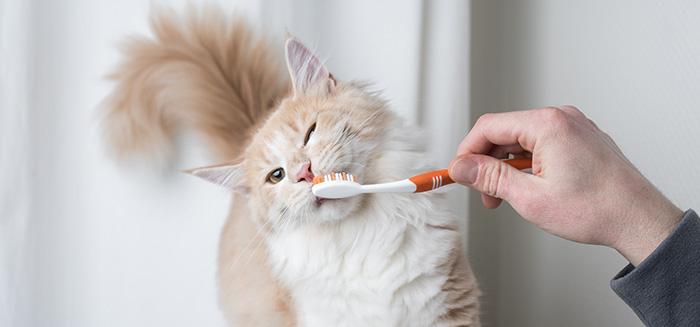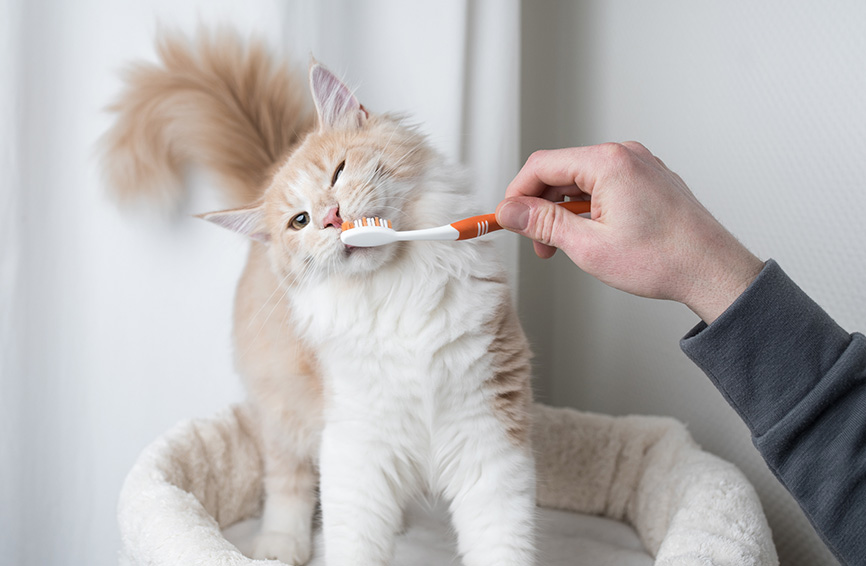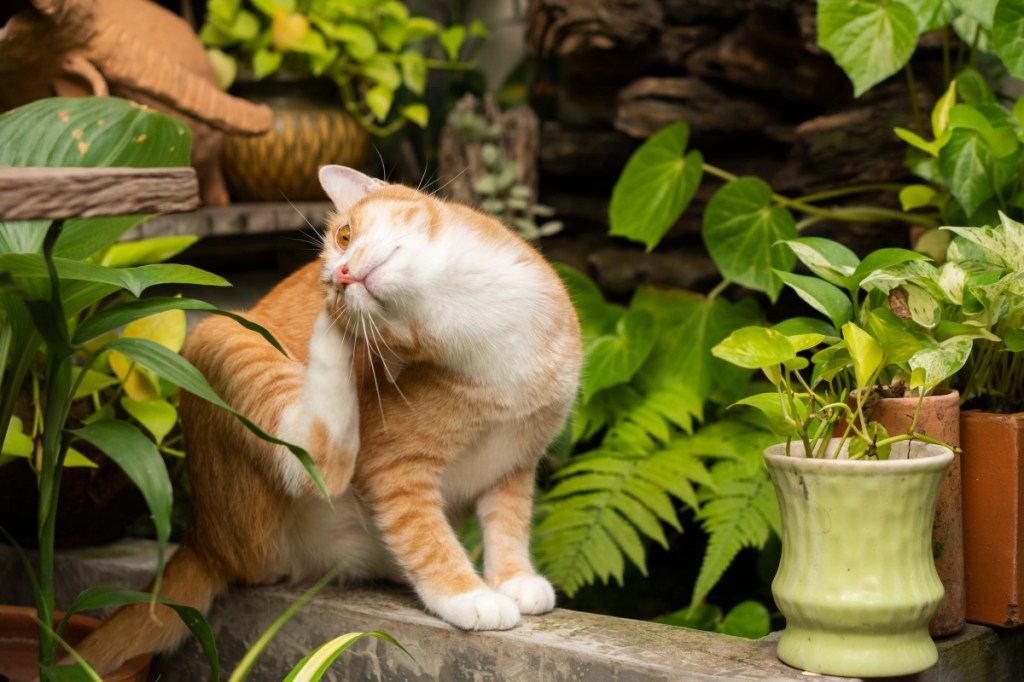Table of Contents
Key Takeaways
- Caring for your cat’s teeth is as essential as other preventative care and will keep your pet from developing related health conditions.
- Regularly brushing your cat’s teeth is key to their oral health.
- You can save money and trips to the store by making your own cat toothpaste, with just a few ingredients you may already have.
If your cat has bad breath, it’s more than just an annoyance when she purrs in your face. Healthy cat mouths do not have a strong odor, so it could be a sign of decay and poor oral health that you can address with teeth cleaning.
By the age of three, close to 70 percent of cats will show signs of dental disease.
While often neglected, dental health is vital for cats. Just like humans, cats can develop periodontal disease, a condition that is like severe cavities, and inflammation or ulcers of the mouth. Of course, other diseases can affect a cat’s mouth so it’s always best to check in with your veterinarian if you have concerns.
Dental disease drastically reduces a cat’s quality of life, and problems aren’t restricted to the mouth! Periodontal disease can lead to secondary infections in the blood, a weakened immune system, and susceptibility to illness in other parts of the body, like the heart or kidneys. At the very least, dental problems can lead to chronic pain and difficulty eating.
And besides hygiene and health benefits, teeth cleaning has the added benefit of giving your cat fresher-smelling breath.
Ideally, experts say we should brush our cat’s teeth every day. If that seems unrealistic, aim for three times a week to keep your kitty’s chompers and gums clean and healthy. It’s best to start this habit when your cat is still a kitten to get them used to accepting the procedure.
Whatever you do, don’t use human toothpaste for the task. Human toothpaste is dangerous for cats since they are likely to swallow it, and it may contain ingredients fluoride and sodium that can make them ill and cause an upset stomach.
You can buy toothpaste specifically for cats or make homemade cat toothpaste, which is easy, has few ingredients that you may already have on hand, and takes only a few minutes.
Do-it-yourself toothpaste also allows you to avoid additional trips to the store, saves you some money, and makes for a quick home project.
With D.I.Y. kitty toothpaste, you can ensure it has only natural, healthy ingredients and no chemicals. It’s also more earth-friendly, as you are reducing the plastic packaging waste and shipping emissions that come with store-bought brands.
Ingredients you can use in homemade cat toothpaste:
- Coconut oil
- Flavorings such as beef or chicken bouillon and parsley
- Kelp
- Turmeric
(While many dog toothpaste recipes call for baking soda, there is some dispute about whether it’s OK for cat toothpaste. A small amount won’t hurt them, but too much could cause stomach upset.)
Four Toothpaste Recipes for Cats
Homemade cat toothpaste recipe from Vetco
Ingredients:
- 1 cup of unrefined, virgin coconut oil
- 1/2 teaspoon of turmeric
- 1/2 teaspoon of kelp
- 1/8th tablespoon of dried parsley flakes
Directions:
- Place one cup of coconut oil in a hot water bath to make it soft and pliable. (Unless it already is)
- Add the turmeric, kelp and parsley flakes.
- Mix thoroughly, store in the fridge between uses.
Easy Natural Homemade Toothpaste Recipe from All Natural Pet Care
Ingredients
- Edible Calcium Montmorillonite Clay (sold as an exfoliate or detox remedy, it will not hurt your cat if swallowed)
Directions
Sprinkle a little clay on a damp infant toothbrush or a piece of damp, sterile gauze wrapped around your finger and brush. Clean the toothbrush thoroughly afterward as it will dry hard.
Several commenters on the All Natural Pet Care website said their cats seem to like the clay’s taste.
Coconut oil toothpaste for cats
Coconut oil is an ingredient in many commercial cat kinds of toothpaste, and several pet blogs say that just using coconut oil by itself makes a good teeth cleaner for cats. Coconut oil contains a high concentration of lauric acid, known for its antimicrobial and anti-inflammatory properties, which fights plaque and gingivitis, says Wilderness Cat.
Ingredient:
- Extra virgin unrefined coconut oil (1 teaspoon per 10 lbs.)
Directions:
You can apply the oil directly to your cat’s teeth and gums using a toothbrush or piece of cloth. Gently scrub your cat’s teeth to physically loosed plaque.
Cat toothpaste to buy
If you’d prefer to buy some toothpaste for your cat, there are several options available. Here are cat toothpastes on Amazon that customers rate as the best:
- Virbac C.E.T. Enzymatic Dog and Cat Toothpaste, $9.44 for 70 grams.
- Vetoquinol Enzadent Enzymatic Toothpaste for Cats and Dogs, $11.29 for 3.2 oz.
- Nylabone advanced oral care dental kit, $10.14
- PET KING Oratene Toothpaste Gel, $13.99 for 2.5 oz.
- Petrodex Dental Kit for Cats, Malt Flavor Toothpaste, $5.99 for 2.5 oz.

How to brush your cat’s teeth
OK, so you’ve committed to making or buying some cat toothpaste, and you are ready to start cleaning. Healthy Paws has some advice on how to brush your cat’s teeth. At first, brushing a cat’s teeth can be mildly stressful and confusing for your furry friend. But the more you do it, the quicker your pet will become comfortable with you cleaning his teeth. Always finish your tooth-brushing session with a treat and lots of praise!
Here are some tips from Banfield Pet Hospital:
- Find a comfortable place, like your lap, or a favorite resting spot for your cat to sit during the toothbrushing session.
- Give your cat a small sample of the toothpaste to introduce the taste.
- Lift the lip to expose the outside surfaces of your cat’s gums and teeth.
- Brush with gentle motions to clean the teeth and gums, as you would your own.
- Clean the outside (cheek-facing) surfaces, as most pets will not allow you to brush the inside surface of the teeth.
- Be sure to reach the back upper molars and canines, as these teeth tend to build up tartar quickly.
Get a professional cleaning regularly too
Like humans, your vet may recommend a professional teeth cleaning for your kitty, usually with general anesthesia. They’ll remove tartar and plaque and recommend further dental procedures if they find problems. According to V.C.A. Hospitals, the examination typically includes dental X-rays and probing to evaluate gum bleeding and periodontal pockets where food can accumulate and decay if not properly cared for.
However, because anesthesia is required, cat teeth cleaning can be pretty pricey – and it isn’t covered by traditional pet insurance. Consider budgeting for annual cleaning, especially if your cat has a history of dental problems. The cost of cleaning cats’ teeth can be anywhere from $150 to $450, depending on your city and the age and health status of your cat. The service should include anesthesia, cleaning, polishing, and fluoride treatment, at a minimum.
How else can I keep my cat’s teeth clean?

In addition to brushing your cat’s teeth, there are many other ways to maintain his dental health. Food, treats, toys, chews, water additives, and oral sprays are all available to promote a healthy mouth. Greenies dental treats, WHISKAS® Dentabites Cat Treats, and Purina DentaLife® Cat Treats are all recommended by the Veterinary Oral Health Council.
What dental care is covered by pet insurance?
The Healthy Paws pet insurance plan covers accidental injury to your cat’s teeth, including extractions and reconstructions. Routine dental care, such as the professional cleanings described above, is considered preventative and is not covered. With preventative at-home and professional cleanings, you can avoid most dental abnormalities or illnesses.
If you are someone who brushes your cat’s teeth regularly (or aspires to), you are a great candidate for pet insurance to help cover the costs of unexpected accidents or illnesses. Start by getting a free quote.








